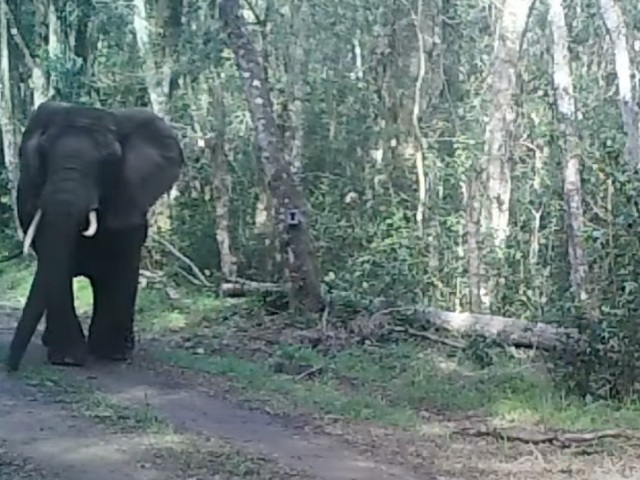[imagesource:youtube/dailymaverick]
In the depths of Garden Route National Park, Strangefoot, the last known survivor of the iconic Knysna forest elephant herd, confronts an uncertain future as conservationists and locals grapple with the dilemma: intervene and save her or let nature take its course.
Her name bestowed by rangers, reflects her strikingly large and wide footprint. Now a wise 50-year-old, Strangefoot – thought to be the last surviving native Knysna elephant in this wilderness – embodies the weight of a fading legacy, a poignant symbol in a heated debate among conservationists who have her well-being top of mind, The Daily Maverick reports.
Once a thriving sanctuary for a stunning herd of 1,000 elephants that gracefully traversed the Afromontane forest and fynbos of the Outeniqua-Tsitsikamma region, the Knysna forest, now part of Garden Route National Park, tells a sorrowful tale of loss.
The San people, the original custodians of the southern Cape, were the first to bear witness to these majestic beings, capturing their essence in evocative rock art. Yet, with the arrival of European settlers in the late 1700s, a dark chapter unfolded as hunting drove elephants away from their ancestral home. By the mid-1800s, the conflict between humans and elephants escalated, leading to a catastrophic decline in their numbers.
Today, only Strangefoot remains—a poignant reminder of a once-great herd, the only elephant consistently tracked in this hauntingly beautiful landscape by South African National Parks (SANParks).
While questions about how many elephants remain in the Knysna forest are still open, Karel Maswati, a dedicated SANParks field ranger who has patrolled the Knysna forest for 34 years, shared with Daily Maverick that he hasn’t seen evidence of more than one elephant in the forest for over two decades.
“When I see her, it feels special,” he said. “Because I don’t think there’s going to be any more.”
Moolman said that when she started the project she hoped there would be five elephants, but “it was only when I got into the field and listened to Karel and Wilfred [SANparks field rangers] and did that camera trap study that [we found evidence of one remaining elephant]”.
A scientific study was published in 2019, and peer-reviewed, confirming what many feared.
“The next question that you probably have is: how is it that you’ve known this for eight years and you haven’t done anything?” said Moolman.
“It’s not that simple,” she explained, noting the complexities of the landscape. The area is heavily fragmented due to historical farming and commercial plantations, with public roads and highways slicing through the elephants’ natural range. Furthermore, the Garden Route National Park operates as an open-access park, lacking fences, which poses significant challenges for introducing more elephants without jeopardising the safety of nearby communities.
“There’s debate about whether the forest can sustain elephants,” Moolman said. “Some believe that if the habitat can’t provide enough nutrition, then bringing in more elephants could lead to further challenges.”
To determine whether reintroducing more elephants is feasible, SANParks is hosting workshops to assess habitat suitability, human-elephant conflict potential, and logistical challenges.
Strangefoot’s solitary existence presents a profound dilemma for conservationists. Some advocate for her to be left undisturbed, while others contend that introducing more elephants could safeguard her genetic lineage. They argue that leaving such a social creature isolated is inherently cruel, raising pressing ethical questions about the future of her kind.
Unfortunately, past experiences don’t provide much positivity, as this isn’t the first time SANParks has grappled with this dilemma. In 1994, after extensive research, they introduced three orphaned elephants, aged seven to nine, from Kruger National Park into the Knysna forest, hoping they would integrate with any remaining local population.
However, the experiment ended in disappointment. One elephant succumbed to stress-related pneumonia shortly after its release, while the other two strayed into nearby farmlands, sparking damage and conflict with local communities. Ultimately, five years later, the two surviving elephants were relocated to a private reserve, marking a sombre chapter in the ongoing struggle to balance conservation and community needs.
Moolman noted that if they are to reintroduce elephants again, they need to learn from our mistakes and to do this, SANParks would need to secure buy-in from the community. She said they need to find out, through community engagement and risk assessments, if communities and farmers can handle the reintroduction of elephants long-term, which they committed to finishing at the end of 2025.
So far, the response has been good with a SANPark survey receiving a 74% response rate from 500 residents keen to support the reintroduction of elephants to the Garden Route.
However, SANParks noted a concerning lack of awareness about elephant coexistence among locals, with many unfamiliar with managing potential interactions. This is particularly concerning considering new elephants introduced may not display the evasive behaviour of the lone Knysna elephant.
To tackle these pressing challenges, SANParks is organising a specialist workshop aimed at discussing the associated risks and benefits with the affected communities.
Notably, the survey revealed that locals primarily value the elephants in this region for their ecological, cultural, and historical significance, rather than for any commercial gain, as highlighted by Moolman.
“People felt that these Knysna elephants are so iconic and historic and cultural, that they did not want them to be tainted by commercial endeavours,” she said.
SANParks faces two possible paths with the confirmation of a lone elephant in the area. However, as JP Louw, the head of SANParks, poignantly remarked, “Fundamentally, there’s no option without a risk.”
Read more as Daily Maverick weighs up the options.
[source:dailymaverick]





